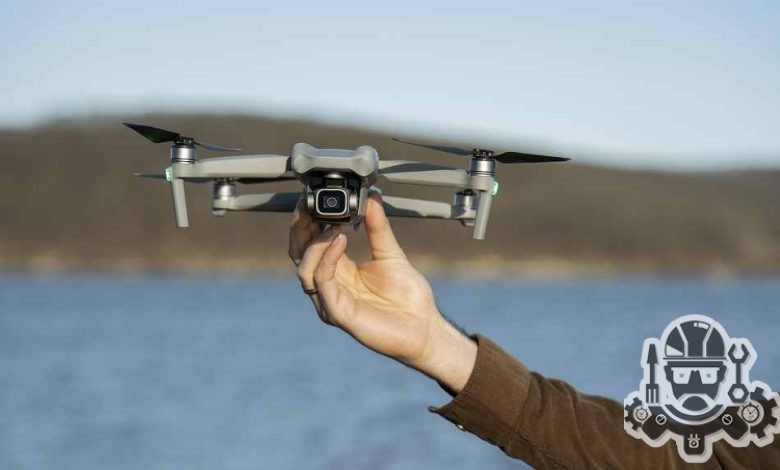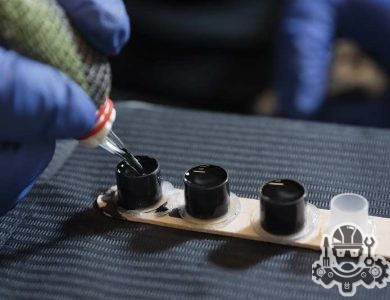Drone Technology & Types Of Drones

Drones, also known as unmanned aerial vehicles (UAVs), are aircraft designed to be operated without human pilots onboard. These flying machines can be controlled remotely from the ground or even autonomously using software-controlled flight plans. The technology behind drones is rapidly advancing, and they are being increasingly used in a variety of industries. In this blog post, we will give you an introduction to drone technology.
Drones can be used for a wide range of activities, from aerial photography and surveying to search and rescue missions. They are also being used in agriculture to assess crop health and monitor field conditions. Moreover, they are used by military and law enforcement agencies for intelligence gathering and surveillance. In the future, experts predict that drones will have even more applications as the technology continues to improve.
| Types of Drones | Features |
|---|---|
| Civilian | Small, lightweight, and cost-effective |
| Military | Built to withstand rough conditions and hostile environments |
| Consumer | Designed for hobbyists and enthusiasts |
There are different types of drones available on the market, each with its own set of features and capabilities. Some are designed for military use, while others are intended for civilian or consumer use. The most common types of drones are fixed-wing, multirotor, and single-rotor, each with their distinct advantages and disadvantages. Fixed-wing drones can cover large areas and stay in the air for hours, while multirotor drones are more maneuverable and can hover in place. Single-rotor drones are capable of carrying heavier payloads and are commonly used in military operations.
Drone technology has come a long way in recent years, and these flying machines are becoming more prevalent in everyday life. With their increasing popularity, it is important to be aware of the regulations and safety guidelines for drone operation to ensure the safety of people and property. As the technology continues to advance, we can expect to see more applications and advancements in the field of drone technology.
Contents
- 1 Applications Of Drone Technology
- 2 Types Of Drones And Their Features
- 3 Latest Advancements İn Drone Technology
- 4 Limitations And Challenges İn Drone Tech
- 5 Regulations And Policies For Drone Operation
- 6 Choosing The Right Drone For Your Needs
- 7 Safety Guidelines For Flying Drones
- 8 Maintenance And Repair Of Drones
- 9 Future Directions İn Drone Technology
Applications Of Drone Technology
Drones have come a long way from their military origins to being a common sight in everyday life. Drones have expanded in various fields to become an essential tool and equipment. The possibilities of drone applications are pretty much endless. The utility of the technology extends to every industry that needs aerial support, human surveillance, or data collection. In these fields, drones are being used to great effect.

Agriculture is an area where drones show their exceptional capability. They are used for crop monitoring and yield collection. In addition, drones can help in planting and pest control. In construction, drones are used to survey construction sites, monitor progress, and ensure worker safety. Aerial photography and cinematography are other industries where drones are commonly used. They help capture aerial shots that were previously impossible.
Search and rescue is another area where drones play a significant role. Drones with cameras mounted on them can locate lost individuals or assist in natural disasters. In law enforcement, drones are used during tactical operations and to monitor critical situations remotely. Finally, transport and delivery are industries where drones show much potential. Companies like Amazon and Google are working towards using drones for package delivery, which will revolutionize logistics and transportation.
| Industry | Applications of Drone Technology |
|---|---|
| Agriculture | Crop monitoring, yield collection, planting, and pest control |
| Construction | Surveying, progress monitoring, and worker safety |
| Aerial Photography and Cinematography | Aerial shots and impossible angles |
| Search and Rescue | Locating lost individuals and assisting in natural disasters |
| Law Enforcement | Tactical operations and remote monitoring |
| Transport and Delivery | Package delivery and transportation |
Applications of drone technology extend to far beyond these specific industries. For example, drones can be used in the media industry, shipping and logistics, and research and training. Additionally, this expansive technology can also serve to improve human life beyond just their practical applications. Drones can be used to assist in humanitarian aid, scientific research, wildlife conservation, and much more. The versatility of drone technology in both commercial and social environments provides plenty of opportunities for creative and effective solutions.
In summary, drones have made a significant impact in various industries and have become essential equipment for commercial purposes. Their high versatility and multiple applications have made them indispensable in many industries. With the ongoing technological advancements, the potential uses of drones will only continue to expand.
Types Of Drones And Their Features
When it comes to drones, people often think of quadcopters or small unmanned aircraft that can capture stunning aerial shots. However, drones come in various types and sizes, each with their unique set of features, applications, and limitations. In this blog post, we will explore the different types of drones available in the market and their features.

The first type of drone is the fixed-wing drone. As the name suggests, these drones have fixed wings, similar to an airplane, which allows them to fly for an extended period. Fixed-wing drones are often used for surveying and mapping, as they can cover a large area in a short amount of time. Their downside is that they require a long runway for takeoff and landing.
Another popular type of drone is the quadcopter. Quadcopters are versatile and agile flying machines that can hover in place, take off vertically, and fly in any direction. They are perfect for aerial photography and video as they provide stable footage even in windy conditions. Drone racing enthusiasts also use quadcopters for high-speed races due to their maneuverability.
| Type of Drones | Features |
|---|---|
| Multi-rotor Drones | Multiple rotors or propellers, stable hovering, low flight time and range |
| Fixed-wing Drones | Fixed wings like an airplane, long flight time and range, require a long runway |
| Single Rotor Helicopters | Single main rotor, maneuverable, expensive, complex control system |
| Hybrid Drones | Combination of fixed-wing and multi-rotor, long flight time and range, versatile |
Single rotor helicopters are also a type of drone that uses a single main rotor and a small tail rotor for control. These drones are highly maneuverable and often used for military and industrial purposes. However, they are expensive, require complex control systems, and have a higher risk of accidents due to the spinning rotor blades.
The last type of drone is the hybrid drone, which combines the features of fixed-wing and multi-rotor drones. Hybrid drones have long flight times and ranges, making them perfect for search and rescue missions or conducting geological surveys. They can take off vertically like a quadcopter and then transition to fixed-wing flight for more extended operations.
Overall, choosing the right drone depends on your needs, budget, and experience. Understanding the different types of drones and their features can help you make an informed decision and get the best possible drone for your application.
Latest Advancements İn Drone Technology
Drone technology has come a long way since it was first introduced to the market. The latest advancements in drone technology are both fascinating and useful. Drones are being used in a variety of industries, including agriculture, construction, and film-making. The newest drones on the market have features that were once only found in science fiction novels. The future of drone technology looks promising, with new advancements being made every day.
One of the most notable recent advancements in drone technology is the development of autonomous flight. Autonomous drones are equipped with sensors and software that allow them to navigate without human intervention. These drones can be programmed to follow a specific route, avoid obstacles, and even land themselves. This technology is being used by companies like Amazon to deliver packages to customers.
Another exciting advancement in drone technology is the use of Artificial Intelligence (AI). Drones equipped with AI can analyze data in real-time and make decisions based on that data. This allows drones to perform complex tasks that would be impossible for a human operator. For example, drones equipped with AI can be used to monitor wildlife and identify rare species. They can also be used to detect crop diseases and pests, allowing farmers to take action before they spread.
| Advancements in Drone Technology | Description |
|---|---|
| Collision Avoidance | Allows drones to detect and avoid obstacles |
| Longer Flight Times | New battery technology allows drones to stay in the air for longer periods of time |
| Higher Quality Cameras | Drones equipped with high-resolution cameras can capture stunning aerial footage |
Advancements in materials science have also played a significant role in the development of drone technology. Lightweight materials like carbon fiber and titanium are being used to make drones that are more durable and easier to maneuver. This has led to the development of smaller drones that can fit in a backpack, yet still have impressive capabilities.
As drone technology continues to evolve, so do the opportunities for their use. We can expect to see drones being used in more industries and for a wider range of tasks in the future. While there are concerns about the safety and privacy implications of drones, regulations and policies are being put in place to ensure that drones are used in a responsible and ethical manner. With the latest advancements in drone technology, the possibilities are endless.
Limitations And Challenges İn Drone Tech
Drone technology has come a long way since its inception. What once was considered a military weapon has now transformed into a versatile tool for various industries. However, with every innovation, there come limitations and challenges.
One of the biggest challenges faced by drones is their limited flight time and range. Most drones that are commercially available can fly for only 20-30 minutes before needing a recharge. Additionally, their range is typically limited to a few hundred meters, which restricts their applications to relatively small areas.
Another limitation is the vulnerability of drones to signal interference. The remote control used to operate the drone can pick up interfering signals, causing the drone to lose control or even crash. This can be especially hazardous in areas with high radio frequency interference, such as cities or near sources of electromagnetic radiation.
| Limitation | Challenge |
| Flight time and range | Restricts applications to small areas unless additional charging options are available |
| Signal interference | Can cause loss of control or even crash the drone |
Moreover, drone technology is faced with regulations and policies that limit their usage. Drones are supposed to operate in designated areas and heights, and operators must be trained and certified to fly drones legally. Governments worldwide are also concerned about privacy concerns and have put in place regulations such as “no-fly” zones where drones are not supposed to fly.
Another significant challenge that comes with drone technology is the cost of acquisition and maintenance. Although drones have become more affordable over the years, advanced drones used for specific applications can cost up to thousands or even millions of dollars. Maintenance and repair of drones can also be expensive, particularly for businesses that use drones extensively, as it requires skilled professionals.
- Flight time and limited range
- Signal interference
- Regulations and policies
- Cost of acquisition and maintenance
In conclusion, while drone technology offers numerous advantages, there exist significant challenges and limitations that need to be addressed. A particular emphasis on battery life, efficient flight range, and signal interference minimization will play a crucial role in maximizing their potential. Additionally, it is important to establish clear policies and regulations to ensure their safe operation and prevent potential privacy violations. Lastly, manufacturers should invest in developing more affordable and easily maintainable drones, making it easier for businesses to adopt this technology for various applications.
Regulations And Policies For Drone Operation
Drone technology has rapidly grown in popularity over the recent years, and as a result, regulations and policies have been put in place to ensure the safety and security of everyone involved. Any person operating a drone is responsible for following the guidelines and restrictions that are set by the authorities. This helps to minimize the chances of accidents or incidents occurring, both in the air and on the ground.
Before indulging in drone operations, you need to familiarize yourself with the rules and regulations governing drone usage in your locality. These policies vary depending on a country or region. For instance, in the US, the Federal Aviation Administration has established the Part 107 rule to regulate and standardize the operation of drones for commercial purposes. This rule outlines various requirements including certification, pilot age restrictions, and operational restrictions.
| Operational Restrictions | Description |
|---|---|
|
Any drone operation that involves any of the above is prohibited unless approved by the FAA |
It is essential to ensure that your drone operation complies with the set regulations and policies to avoid legal repercussions that may result in hefty fines and penalties. Following the policies ensures a safer environment for drone pilots, bystanders, and users. Additionally, the compliance with the regulations and policies guarantees a bright future for drone technology by fostering a positive relationship with authorities and the public.
Choosing The Right Drone For Your Needs
When it comes to choosing the right drone for your needs, there are a few important factors to consider. The first thing you should think about is your budget. Drones can range in price from a few hundred dollars to several thousand, so make sure you know your budget before you start shopping.
The next thing to consider is the purpose of your drone. Are you planning on using it for recreational purposes or for professional projects? Different drones have different capabilities and features that make them better suited for certain tasks. For example, if you’re planning on using your drone for aerial photography, you’ll want to find a model with a high-quality camera and stabilizing features.
- Budget
- Purpose of the drone
- Features required for intended tasks
| Type | Features | Price Range |
|---|---|---|
| Recreational | Lightweight, easy to control, camera not a priority | $200-$1000 |
| Professional | High-quality camera, advanced sensors, long battery life | $1000-$5000+ |
| Racing | Fast speeds, maneuverability, durable construction | $200-$1000 |
Lastly, you’ll want to think about the features you need to get the most out of your drone. This could include things like GPS capabilities, obstacle avoidance technology, and long battery life. Additionally, make sure you understand the regulations and policies for drone operation in your area.
By considering these factors, you can make an informed decision when it comes to choosing the right drone for your needs. Remember to do your research and read reviews from other users to ensure you’re getting the best drone for your money.
Safety Guidelines For Flying Drones
Flying drones can be a thrilling experience, but it is important to prioritize safety to avoid accidents and potential harm. The growth of drone technology has increased the risks of accidents and collisions, hence it is essential for any drone operator to follow safety guidelines while flying. Here are some tips to ensure safe and enjoyable drone flights:
Choose a Safe Location: Always fly your drone in a safe location that is authorized for drone flights. Avoid flying near hospitals, schools, airports, or crowded areas. Look out for power lines, trees, and other obstacles that might interfere with your flight, and ensure you have a clear flight path to avoid any collisions.
Check Weather Conditions: Before flying your drone, check weather conditions to make sure it is safe to fly. Avoid flying during heavy rainfall, thunderstorms, and strong winds as this can affect the performance of your drone.
| Do’s | Dont’s |
|---|---|
| Do fly within visual line-of-sight | Don’t fly over people or moving vehicles |
| Do yield the right of way to manned aircraft | Don’t fly near emergency response efforts such as fires |
| Do take a pre-flight inspection | Don’t fly at night without proper lighting |
| Do follow FAA regulations | Don’t fly under the influence of drugs or alcohol |
Do a Pre-flight Inspection: Ensure that your drone is in good condition before every flight. Check your drone for cracks, loose parts, or any other malfunctions. Also, ensure that your drone’s battery is fully charged before takeoff.
Follow FAA Regulations: The FAA has set specific rules and regulations to govern drone operations. Always ensure that you follow the regulations by registering your drone, obtaining a pilot certification, and complying with airspace restrictions. This will help you avoid fines or other legal consequences.
By following these safety guidelines, you can enjoy the experience of flying a drone while minimizing the risk of danger or damage. Always prioritize your safety and the safety of others while operating your drone. Stay safe and happy flying!
Maintenance And Repair Of Drones
Drones have become a popular tool for capturing stunning aerial footage, and they are also being used for a range of other applications such as surveying, crop monitoring, and even delivering packages. However, like any electronic device, drones require regular maintenance and occasional repairs to ensure optimal performance and longevity. In this article, we will discuss the importance of maintenance and repair of drones and some tips to keep your drone in top condition.
It’s essential to conduct regular maintenance checks on your drone to avoid costly repairs and prevent accidents. Firstly, ensure that the propellers are clean and free from dirt or debris, as any buildup can cause them to malfunction. Battery life is also a crucial aspect of drone maintenance, so inspect the batteries for any physical damage or wear and tear. Additionally, ensure that the firmware is up to date and check for any software updates available from the manufacturer.
| Step | Action |
|---|---|
| 1 | Inspect the propellers for dirt or debris |
| 2 | Check the batteries for damage |
| 3 | Update the firmware |
If your drone requires repairs, it’s important to follow the manufacturer’s guidelines and avoid attempting to repair it yourself, unless you have sufficient expertise. Drone repairs can be complicated and require specialized tools and knowledge, so it’s advisable to seek the assistance of a professional repair service. Attempting to repair your drone yourself could cause further damage, or even render the drone unusable.
Regular maintenance and prompt repairs are crucial for extending the life of your drone and improving its performance. By conducting checks, following guidelines, and seeking professional assistance, you can ensure that your drone is always operating at its best.
Future Directions İn Drone Technology
Drone technology has proven to be a game-changer in various industries. From agriculture to cinematography, drones have become an essential tool. As the technology progresses, the future of drones seems incredibly promising. In this blog post, we will explore the future directions in drone technology.
One of the significant areas of development in drone technology is automation. The integration of advanced sensors and artificial intelligence will allow drones to perform tasks autonomously. As a result, this will reduce the requirement for human control and make drone operations more efficient.
Another area of development is the utilization of drone swarms. As the name suggests, this involves multiple drones working together to perform complex tasks. We have seen some examples of drone swarms being used for military applications, but the potential of drone swarms extends beyond the military. For instance, they can be used to conduct search and rescue operations in disaster-struck areas.
| Prospective directions in drone technology |
|---|
| AI and advanced sensors for autonomy |
| Drone swarms for complex tasks |
| Delivery drones for rapid deliveries |
- One of the most prominent applications of drones is in the delivery industry. With Amazon leading the way, we can expect to see more companies adopting drone delivery services soon. This will revolutionize the delivery industry by providing faster and more efficient deliveries.
- The healthcare industry is another area where drones can make a significant impact. Drones can be used for medical supply delivery in remote areas, providing faster and more efficient services to patients in need.
- Lastly, the use of augmented reality technology with drones is another area of development. This could create a more immersive and interactive experience for drone operators, making drone operations more accessible and user-friendly.
In conclusion, the future of drones appears to be incredibly bright. With automation, drone swarms, delivery drones, medical supply delivery, and augmented reality, there are numerous opportunities for innovation and progress. As technology advances, we can only expect that the potential of drones will continue to grow.



